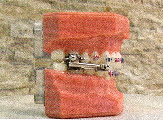Pediatric orthodontics is generally described as treatment provided before braces. We term it early treatment. This is before all the permanent teeth have erupted. We have been providing this category of care in our offices for over 35 years.
The American Association of Orthodontics recommends an initial orthodontic screening for all children around age 7. This is the optimal time to evaluate space requirements and jaw alignment. Treatment during this age period is directed at guiding the growth and development of the teeth and jaws. It is important that problems at this age be evaluated by an orthodontist with expertise in early treatment.
Conditions that are best treated "early" are generally related to crowding and bite problems caused by jaw alignment. The list of conditions include cross bite, open bite, over bite, severe crowding, gummy smiles and problems related to thumb and finger habits.
Early Treatment can:
- Create room for crowded teeth so that they come in normally
- Create facial balance by influencing proper jaw growth
- Reduce the risk of damage to protruding front teeth
- Eliminate the need to extract permanent teeth to correct crowding
- Reduce the time a patient spends in braces
- Eliminate unwanted and harmful habits
The problems corrected by early treatment will have positive effects on your child's appearance and self esteem. Equally important are the positive effects on dental health.
For example, protruding teeth are more susceptible to accidental chipping and other types of traumatic damage. Crossbites can result in unbalanced jaw growth and excessive wear of teeth. Open bites can cause speech impediments and problems with swallowing and digestion. Uncorrected over bites can lead to jaw joint (TMJ) problems. The most common early treatment appliances are expansion appliances, which widen the teeth and jaws laterally, making room to align crooked teeth and promoting proper eruption of permanent teeth not yet erupted. Properly managed expansion therapy will also promote symmetrical lateral positioning of the lower jaw.
Head gear therapy is commonly used in early treatment to control the position of the upper teeth. There are three types, but all have their primary impact on the upper teeth.
The Herbst appliance is also utilized for anterior/posterior bite correction. Unlike the head gear, which primarily impacts the upper teeth and upper jaw, the Herbst appliance is used to control the position of the the lower jaw. The majority of over bites are due to the position of the lower jaw and the Herbst appliance is one of the best appliances that provides the desired orthopedic impact on the lower jaw. With modern digital diagnostics, we can precisely assess the position and size off the lower jaw and manipulate the Herbst appliance to place the lower jaw in its ideal structural and functional positions.
Other appliances:
Other appliances frequently used in early treatment include:
- Lip Bumpers are used on the lower teeth to alleviate crowding by making space in the anterior/posterior direction.
- Bite Plates/Retainers are used in patients with significant over bites where the front teeth tip out and the the lower front teeth contact the tissue behind the front teeth. We use these retainers to move the upper front teeth back so that they are not at risk from damage due to trauma. This will also unlock the bite so that the gum tissue behind the front teeth will not be damaged.
- Partial braces are often used to align the front teeth and place them in their proper position after we have created the necessary space.
- Space maintainers are used most often to hold space for erupting permanent teeth when deciduous (baby) are lost prematurely. Space maintainers can also be used when space is adequate but not properly distributed.
Other considerations
Other considerations in early treatment protocols include:
- Frenectomies: The frenum is a band of muscle fibers that stabilizes the upper lip. In some patients, this band of muscle fibers attaches in between the upper front teeth, resulting in a persistent space. In these cases. the usual recommendation is to have these muscle fibers severed. This is typically done by laser in the dental office. It is a relatively simple procedure.
- Extractions: If a permanent tooth is developing but not moving into precisely the correct position, the root on the deciduous (baby) tooth may not dissolve properly. In that scenario, it is generally prudent to extract the deciduous tooth so that the permanent tooth moves into its appropriate position.
In Summary: early exam
The American Association of Orthodontics recommends initial examination with an orthodontist by age seven. This affords us the opportunity to identify significant problems early in their development, which usually leads to more predictable outcomes with less complicated treatments.
When early treatment is indicated, the resultant growth guidance and tooth movement generally results in less time in braces when that treatment is initiated, with a better functional and aesthetic outcome. In addition, most patients treated early do not require extraction of permanent teeth.
In our office, initial examinations are provided free of charge. We do not want there to be any barrier to our patients pursuing that initial appointment, which is often concerning for both our patients and their parents. There is much that we can do early on, often with greater ease than initially anticipated to guide growth and development, so that seemingly severe problems can be effectively dealt with before they turn into larger more complex problems.

Before Treatment: narrow jaw width, crowding, bite open in front

After Treatment: improved jaw width, nicely aligned front teeth, bite together

Palatal Expander in place

Herbst Appliance with bite correction adjustment mechanism
